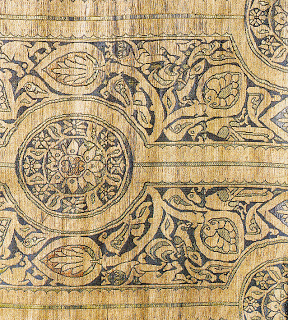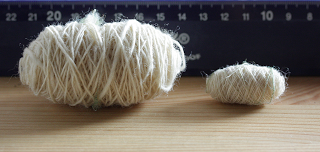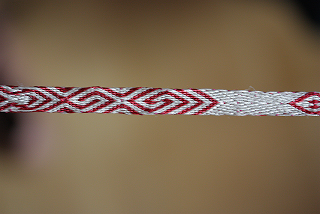I'm feeling like something classy and really pricey today. So here's something for those that feel like me: A fabric photo of so-called "St. Elisabeth's Cloak". It is a silk and gold fabric, woven probably in Sicily, 2nd quarter 13th century. It's in a Elisabethine convent in Klagenfurt nowadays.

I'm amazed again and again by cloth like this. Something made of rich gold-and-silk must have been worth a fortune, or several fortunes, and still it was woven, sold and made into garments. In some cases, there has been so much gold in old garments that it could be "recovered" from church garments after secularisation - by burning the cloth.
And, as usual, using finer threads or costly materials isn't the only thing for "upgrading". Instead, the fine, expensive materials are usually connected to more work, more complicated patterns - even if halving the thread thickness would already mean more work time, because of four times the number of threads.
But then, textile work seems to always rise exponentially when going finer or more complicated. Thinner threads for weaving? Much more work, regardless of loom type (and it is also true for tablet weaves). Smaller mesh for netting? Much more work. Thinner threads for embroidery? You know the answer. Add an extra pattern weft? Guess what happens. Braiding with fine threads? Uuuuh, takes ages. And it doesn't start with handling and manipulating threads - it starts with making them. Spinning fine will mean more time needed to spin for the same amount of fabric - because half the thread thickness means four times the number of threads. And then, spinning fine makes reattaching the spindle after a break more difficult; increasingly difficulty with thinness. I've tried to go as thin as possible, and sometimes it takes several tries after the thread broke to get a good connection between spun and unspun again. So it really pays to spin a little slower and with more concentration - and once more, it takes longer.
It's the same every time you go "finer, thinner, more" with textile: Work time does not scale up proportional to thread thickness. And that's something to keep in mind when looking at historical textiles, too.
Picture source: TROPPER, PETER (Hrsg.): Hemma von Gurk. Katalog der Ausstellung auf Schloß Straßburg/Kärnten, 14. Mai bis 26. Oktober 1988. Klagenfurt 1988.

I'm amazed again and again by cloth like this. Something made of rich gold-and-silk must have been worth a fortune, or several fortunes, and still it was woven, sold and made into garments. In some cases, there has been so much gold in old garments that it could be "recovered" from church garments after secularisation - by burning the cloth.
And, as usual, using finer threads or costly materials isn't the only thing for "upgrading". Instead, the fine, expensive materials are usually connected to more work, more complicated patterns - even if halving the thread thickness would already mean more work time, because of four times the number of threads.
But then, textile work seems to always rise exponentially when going finer or more complicated. Thinner threads for weaving? Much more work, regardless of loom type (and it is also true for tablet weaves). Smaller mesh for netting? Much more work. Thinner threads for embroidery? You know the answer. Add an extra pattern weft? Guess what happens. Braiding with fine threads? Uuuuh, takes ages. And it doesn't start with handling and manipulating threads - it starts with making them. Spinning fine will mean more time needed to spin for the same amount of fabric - because half the thread thickness means four times the number of threads. And then, spinning fine makes reattaching the spindle after a break more difficult; increasingly difficulty with thinness. I've tried to go as thin as possible, and sometimes it takes several tries after the thread broke to get a good connection between spun and unspun again. So it really pays to spin a little slower and with more concentration - and once more, it takes longer.
It's the same every time you go "finer, thinner, more" with textile: Work time does not scale up proportional to thread thickness. And that's something to keep in mind when looking at historical textiles, too.
Picture source: TROPPER, PETER (Hrsg.): Hemma von Gurk. Katalog der Ausstellung auf Schloß Straßburg/Kärnten, 14. Mai bis 26. Oktober 1988. Klagenfurt 1988.






